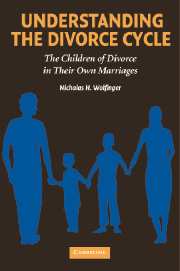Book contents
- Frontmatter
- Contents
- Preface
- Acknowledgments
- 1 Introduction
- 2 Why Divorce Begets Divorce
- 3 Coupling and Uncoupling
- 4 How Strong Is the Divorce Cycle?
- 5 Historical Developments
- 6 The Cohabitation Revolution
- 7 Conclusion
- Appendix A Data and Methods
- Appendix B Evaluating the Role of Marriage Differentials in the Weakening Divorce Cycle
- Notes
- Bibliography
- Index
7 - Conclusion
Published online by Cambridge University Press: 27 July 2009
- Frontmatter
- Contents
- Preface
- Acknowledgments
- 1 Introduction
- 2 Why Divorce Begets Divorce
- 3 Coupling and Uncoupling
- 4 How Strong Is the Divorce Cycle?
- 5 Historical Developments
- 6 The Cohabitation Revolution
- 7 Conclusion
- Appendix A Data and Methods
- Appendix B Evaluating the Role of Marriage Differentials in the Weakening Divorce Cycle
- Notes
- Bibliography
- Index
Summary
Although divorce rates have dipped since the record highs of the late 1970s, they remain higher than at any other time in American history. All of the conditions responsible for the divorce boom are likely to persist for the foreseeable future: A mass exodus of women from the workplace hardly can be imagined; people will continue to feel entitled to escape unhappy marriages; and it is highly unlikely that American standards of living will regress to pre-1950s levels – which would preclude divorce by making it more difficult to live by oneself. There is no reason to expect that rates ever will return to the levels of the 1950s.
The declines in divorce of the past twenty-five years portend the magnitude of any future changes in the divorce rate. Fluctuations in relative cohort size and the economy may bring about change, but as history has shown, any effect on the divorce rate is likely to be temporary. Events similar to the demobilization of servicemen after World War II could precipitate brief but acute spikes in the divorce rate. There is a greater point to be made here: The 1965–79 divorce boom represented the culmination of a trend that extended back hundreds of years – that is, as far back as divorce rates have been recorded. Perhaps the only thing that could drive down divorce rates would be drastic legal measures. Although ill-advised, legislative responses to the divorce “problem” are not entirely implausible.
- Type
- Chapter
- Information
- Understanding the Divorce CycleThe Children of Divorce in their Own Marriages, pp. 105 - 126Publisher: Cambridge University PressPrint publication year: 2005



